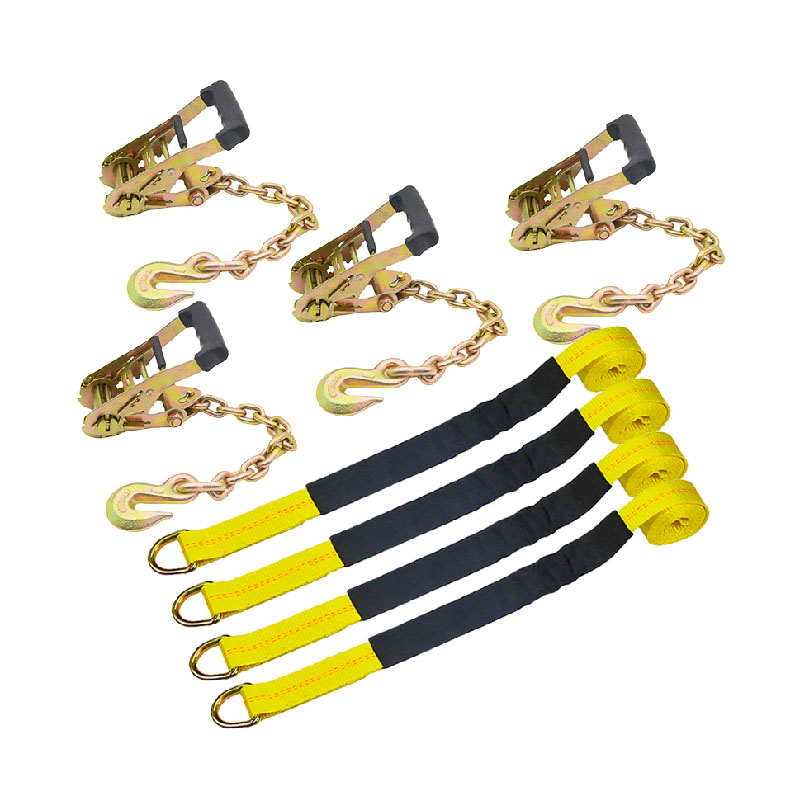All About Wheel Lift Straps: Essential Tools for Safe Towing
2024-10-16
When it comes to towing vehicles, ensuring safety and stability is critical. Among the most reliable tools in the towing industry are wheel lift straps. These heavy-duty straps secure the wheels of a towed vehicle, keeping it in place during transport. Whether you're a tow truck operator or someone in the business of vehicle recovery, understanding the importance of these straps is essential for efficient and secure towing.
In this blog, we’ll explore what wheel lift straps are, their uses, how to select the right straps, and tips for safe usage.
What Are Wheel Lift Straps?
A wheel lift strap is a durable strap designed to secure a vehicle's wheels to a towing apparatus, such as a wheel lift or flatbed. These straps are typically made from high-strength polyester webbing, which is known for its resistance to stretching, abrasion, and the elements. They often feature ratchets, hooks, or loops for easy tightening and anchoring.
Wheel lift straps are crucial for preventing the movement of the towed vehicle during transit, reducing the risk of accidents and ensuring a smooth towing experience.
Common Uses of Wheel Lift Straps
1. Towing with Wheel Lifts
- Tow trucks with wheel lifts use these straps to secure the front or rear wheels of a vehicle during transportation.
- Straps ensure that the wheels remain firmly attached to the lift arms.
2. Flatbed Transport
- When vehicles are loaded onto flatbed tow trucks, wheel lift straps secure the tires to the deck, preventing the vehicle from shifting.
3. Vehicle Recovery Operations
- Recovery teams use wheel lift straps to stabilize vehicles stuck in difficult situations, such as accidents or off-road recoveries.
4. Long-Distance Towing
- These straps are especially useful for cross-country towing or transporting vehicles over rough terrain, where consistent security is critical.
Key Features of High-Quality Wheel Lift Straps
- Heavy-Duty Webbing Material
- Made from polyester webbing for high strength and durability.
- Resistant to UV rays, water, and chemicals, ensuring long-lasting performance.
- Adjustable Ratchet Mechanisms
- Many straps come with ratchet systems for easy tightening and proper tension control.
- Protective Sleeves
- Some wheel lift straps feature padded sleeves to protect the tires and rims from damage.
- High Working Load Limit (WLL)
- The WLL determines how much weight the strap can handle without breaking. Make sure to choose straps with a sufficient load rating for the vehicles you plan to tow.
- End Hooks and Loops
- Different types of end fittings, such as flat hooks, J-hooks, and loops, allow secure attachment to various tow points.
Types of Wheel Lift Straps
1. Flat Hook Straps
- Feature flat metal hooks on the ends for easy anchoring to lift arms or trailers.
2. Ratchet Straps with Loops
- Have loops at the ends and a ratchet system for precise tensioning. Perfect for securing tires on flatbeds.
3. Over-the-Wheel Straps
- Designed to wrap over the top of the wheel, providing extra stability. Ideal for vehicles with larger or off-road tires.
4. Axle Straps
- Instead of wrapping around the wheels, these straps wrap around the vehicle’s axle and attach to the lift arms or trailer.
How to Choose the Right Wheel Lift Strap
1. Determine the Strap Length and Width
- Measure the diameter of the vehicle’s tires and choose straps long enough to secure them properly.
- Wider straps (2-4 inches) provide better coverage and stability.
2. Check the Load Capacity
- Ensure the Working Load Limit (WLL) of the strap exceeds the weight of the vehicle being towed.
- Look for straps with a safety factor of 3:1 or higher to ensure durability.
3. Select the Appropriate End Fittings
- Choose hooks, loops, or D-rings that are compatible with your tow truck’s lift points or flatbed.
4. Inspect Material Quality
- Opt for polyester straps due to their excellent resistance to weather and abrasion.
5. Consider Protective Sleeves
- Straps with padded sleeves help protect the tires and rims from scratches during towing.
Tips for Safe Usage of Wheel Lift Straps
1. Inspect Straps Regularly
- Check for signs of wear, fraying, or damage before each use. Replace damaged straps immediately.
2. Ensure Proper Tension
- Tighten the straps securely using the ratchet mechanism, but avoid over-tightening, which can damage the tires.
3. Use the Right Number of Straps
- For flatbed towing, secure each wheel with a separate strap to prevent the vehicle from shifting.
4. Avoid Sharp Edges
- Ensure the straps don’t come into contact with sharp parts of the vehicle or tow truck, as this could cause tearing.
5. Monitor During Transit
- Periodically check the straps during long hauls to ensure they remain tight and secure.
Benefits of Using Wheel Lift Straps
- Enhanced Safety: Prevents vehicles from moving or shifting during towing, minimizing the risk of accidents.
- Versatile Use: Suitable for wheel lifts, flatbeds, and vehicle recovery operations.
- Durability: Made from high-quality materials that withstand heavy loads, weather exposure, and wear.
- Easy Installation: Ratchet systems and hooks make securing the straps quick and hassle-free.
- Tire Protection: Padded sleeves prevent damage to tires and rims during transport.
Conclusion
Wheel lift straps are an indispensable tool for anyone involved in towing or vehicle recovery. Their ability to secure vehicles safely and efficiently ensures smooth transport, whether you're towing across town or across the country. By choosing the right type of strap and following best practices for installation and maintenance, you can ensure that your towing operations are both safe and effective.
Investing in high-quality wheel lift straps will save you time, money, and headaches in the long run. Make sure to inspect and replace them regularly to keep your operations running smoothly.



